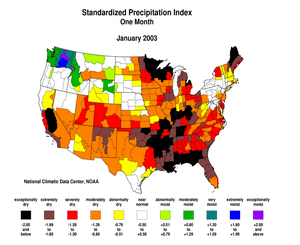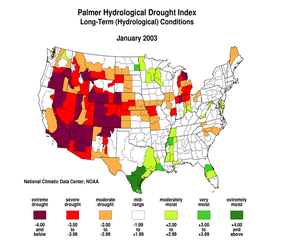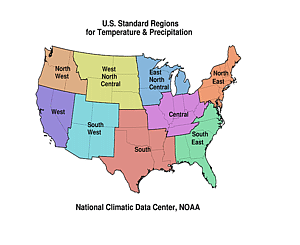|
Use these links to access detailed analyses of Global and U.S. data.

|
| January marked the second consecutive wet month averaged across the Pacific Northwest, contributing to some improvement in drought conditions in the region, but long-term deficits remained. The month averaged much drier than normal for the West and Southwest regions. |
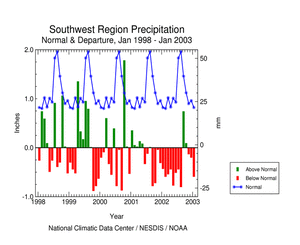 |
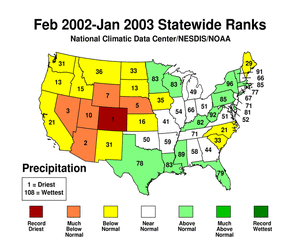 |
| Moderate to extreme drought covered 75% of the western U.S. (Rocky Mountains to west coast) at the end of January. This makes the current drought the most extensive for this region since the drought of the 1930s. Of particular concern was the below-average mountain snowpack, as seen in snow course measurements and SNOTEL station snow water equivalent observations, and below-average reservoirs. The winter mountain snowpack is the source of spring meltwater which fills western reservoirs and is used for irrigation during the spring and summer growing seasons. |
A detailed review of drought conditions is available for several western states and regions.
 Central U.S. Drought
Central U.S. Drought
| January was unusually dry across much of the central U.S., with the Great Lakes (East North Central region) and southern Plains (South region) experiencing the third driest January in the 109-year record, and the Ohio Valley (Central region) having the fifth driest January on record. This month marked the third consecutive dry month for the East North Central region, which experienced the driest December-January and November-January on record. |
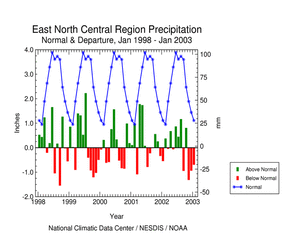 |
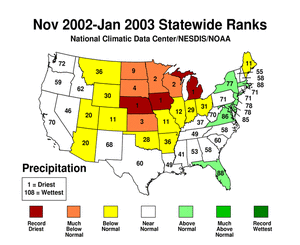 |
| The dryness has significantly depleted soil moisture from the central Plains to the Great Lakes. This is evident in modeled soil moisture departures as computed by the NOAA Climate Prediction Center and the Midwest Regional Climate Center at both the top soil layers and deeper layers. The drought has caused significant crop losses in the states of the West North Central region and near-record low levels for the Mississippi River at St. Louis. |
| A detailed review of drought conditions is available for several central U.S. states and regions. |
 Eastern U.S. Drought
Eastern U.S. Drought
|
The dryness of January marked the end of a four-month wet spell for much of the east coast. Most areas here had recovered from the drought by the end of December, with only long-term hydrologic impacts (for example, low well levels) remaining. But January's dryness increased the moisture stress in many areas, with the Southeast region having the fourth driest January, regionwide, in the 109-year record. An exception is Maine, where four of the last six months have averaged drier than normal, statewide. Maine had the third driest January and fourth driest August-January in the 109-year record.
A detailed review of drought conditions is available for several eastern states and regions. |
 |
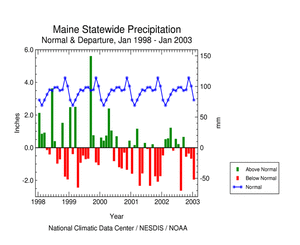 |

 Additional Contacts:
Additional Contacts:
Damage due to the drought has been summarized by NOAA and the Office of Global Programs in the Climatological Impacts section of the Climate Information Project. Crop impact information can be found at the USDA NASS (National Agricultural Statistics Service) and Weekly Weather and Crop Bulletin pages. Drought statements by local National Weather Service Offices can be found at the NWS Hydrologic Information Center. Drought threat assessments and other information can be found at NOAA's Drought Information Center. Additional drought information can be found at the National Drought Mitigation Center, the USDA's National Agricultural Library, the interim National Drought Council, and the NOAA Paleoclimatology Program. The following states have set up web pages detailing current drought conditions and/or their plans to handle drought emergencies:
For additional information on current and past wildfire seasons please see the National Interagency Fire Center web site or the U.S. Forest Service Fire and Aviation web site. NCDC's Drought Recovery Page shows the precipitation required to end or ameliorate droughts and the probability of receiving the required precipitation. Additional climate monitoring graphics can be found at the Climate Prediction Center's monitoring pages:
Drought conditions on the Canadian prairies can be found at the Agriculture and Agri-Food Canada Drought Watch page. |

 For all climate questions other than questions concerning this report, please contact the National Climatic Data Center's Climate Services Division:
For all climate questions other than questions concerning this report, please contact the National Climatic Data Center's Climate Services Division:
Climate Services DivisionFor further information on the historical climate perspective presented in this report, contact:
NOAA/National Climatic Data Center
151 Patton Avenue
Asheville, NC 28801-5001
fax: 828-271-4876
phone: 828-271-4800
email: ncdc.info@noaa.gov
Richard Heim-or-
NOAA/National Climatic Data Center
151 Patton Avenue
Asheville, NC 28801-5001
fax: 828-271-4328
email: Richard.Heim@noaa.gov
Jay Lawrimore
NOAA/National Climatic Data Center
151 Patton Avenue
Asheville, NC 28801-5001
fax: 828-271-4328
email: Jay.Lawrimore@noaa.gov

 NCDC / Climate Mon. / Climate-2003 / January / U.S. Drought / Regional / Search / Help
NCDC / Climate Mon. / Climate-2003 / January / U.S. Drought / Regional / Search / Help
Downloaded Friday, 24-Oct-2008 21:17:50 EDT
Last Updated Friday, 18-Nov-2005 14:11:55 EST by Richard.Heim@noaa.gov
Please see the NCDC Contact Page if you have questions or comments.


